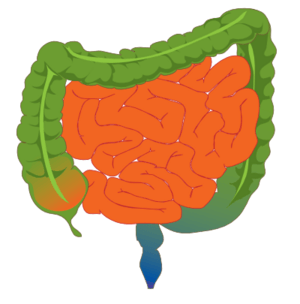Intestine facts for kids
The digestive system is a super important team of organs inside your body. It's like a long, twisting tube, also called the GI tract or gut. Its main job is to take the food you eat, break it down into tiny pieces, and then pull out all the energy and nutrients your body needs to grow and stay healthy. Anything your body can't use is then sent out as waste.
Different animals have different digestive systems. For example, some animals have stomachs with many parts!
How Your Body Digests Food
Imagine your food going on a journey through your body!
The first stop is your mouth, where you chew your food and mix it with saliva. This starts to break it down. Then, the food slides down a tube called the esophagus and lands in your stomach.
In your stomach, strong acids and special juices continue to break down the food even more. After the stomach, the food moves into the small intestine. This is where most of the magic happens! Tiny, useful parts of the food, called nutrients, are absorbed through the walls of the small intestine and go into your bloodstream. Your blood then carries these nutrients all over your body to feed your cells.
What's left of the food, the parts your body can't use, then travels into the large intestine. Finally, these waste materials are expelled from your body.
The inside of this long digestive tube is lined with a special layer called the mucosa. In your mouth, stomach, and small intestine, this mucosa has tiny glands. These glands make the juices that help break down your food.
Why Digestion Matters So Much
When you eat yummy things like bread, meat, or vegetables, they aren't in a form your body can use right away. Think of it like a big Lego structure that needs to be broken down into individual bricks before you can build something new.
Your food and drinks need to be changed into much smaller pieces, called molecules. Once they are tiny enough, they can be absorbed into your blood. Your blood then acts like a delivery service, carrying these small nutrient molecules to every single cell in your body.
Digestion is the amazing process that breaks down everything you eat and drink. This way, your body can use those tiny parts to build new cells, keep your existing cells healthy, and give you all the energy you need to run, play, learn, and grow!
See Also




